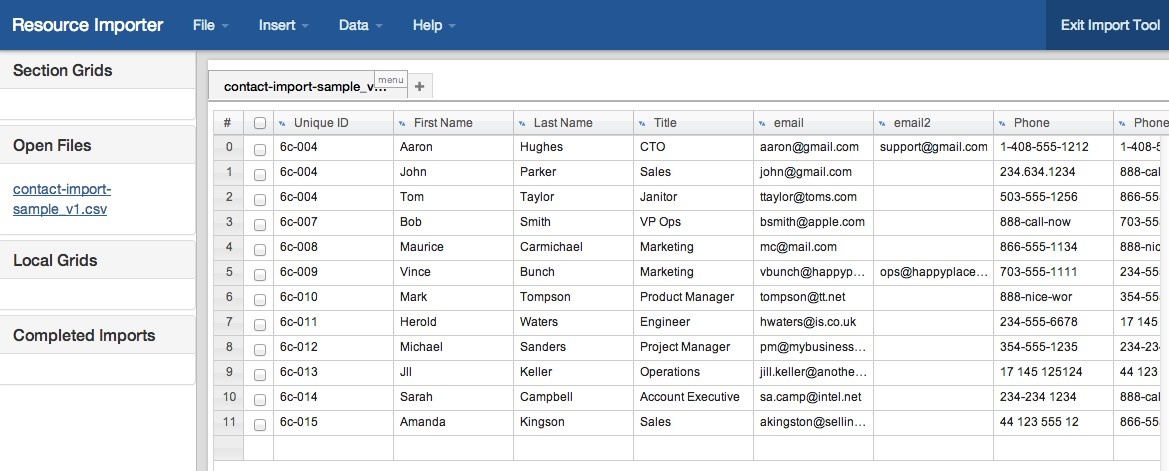Importing Resources
Before You Begin
Ensure that you are familiar with the overview and "Before you Begin" requirements listed on the Resource Import Tool page.
For this walkthroughtutorial, we will be using the Contact Import Sample .csv available on the Import Templates page as an example, and associating it to an existing Section called "Contact" having the fields: First Name, Last Name, Email, 2nd Email, Phone, 2nd Phone, Mobile Phone, Role, and Time Zone. To create this Section, or edit an existing Section, refer to Working With Resources, Customizing Sections, and Customizing Fields.
In order to illustrate the abilities of the Resource Importer to edit data and adjust for formatting issues, the Contact Import Sample .csv is used intentionally leaving a few less-than-ideal conditions (much like you may encounter in real life) such as leaving typos, having an extra data column, and missing a needed column. If you follow the "Before you Begin" requirements and "Best Practice" notes, however, you may be able to skip any editing or column adjustment steps.
When you are ready to begin, open the Resource Importer and proceed to Step 1.
Step 1: Upload your .csv data file
Under the "File" Menu, select "Open .csv". Browse to and select your UTF-8 encoded data file.
...
After hitting "OK", your file should be visible in the workspace, as well as listed under "Open Files" like this:
After opening your .csv grid, proceed to Step 2
...
...
Under the "Data" menu, select "Create Sheet from Section".
The Resource Browser will pop up, showing the list of Sections currently available in Provision. Clicking on the "Details" button will show the fields for that Section.
Verify that the Section and available fields match the type of data you are trying to import. In this case, the Section "Contact" has the fields that correlate to our spreadsheet data.
Select "Create Grid" to create a grid based off this Section.
When the Section Grid has been created, required fields will show in blue font with (required) after the header, in this case, "Name" is a required field. The "Custom ID" field is metadata allowing for a unique ID to be associated with each entry, but is not necessary for a successful import. The remainder of the headers directly match the Section's fields.
Step 3: Reorder .csv columns to match the Section Grid column order
One of the most important steps is to reorder the columns from the .csv data to match the order of the Section Grid - think of the importer as copying and pasting the csv data into the "Contact" Section grid, we want to ensure that the data is under the correct headers! There are a couple of methods you can use to reorder columns in the Resource Importer:template grid from an existing Section

